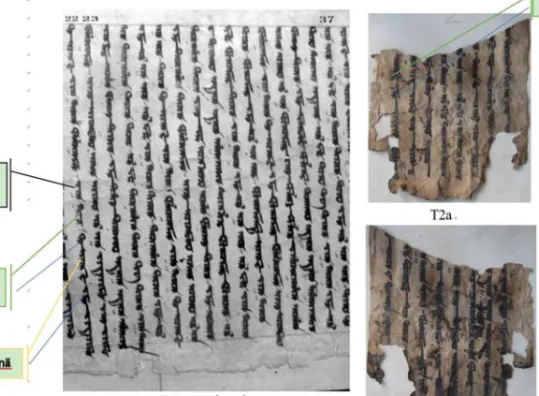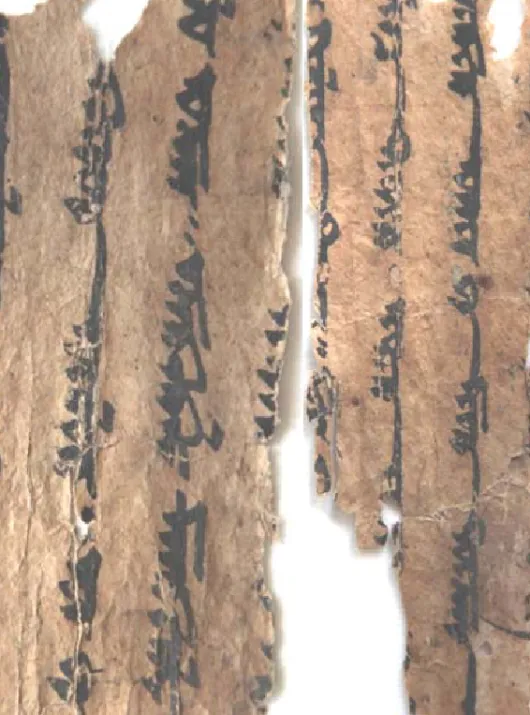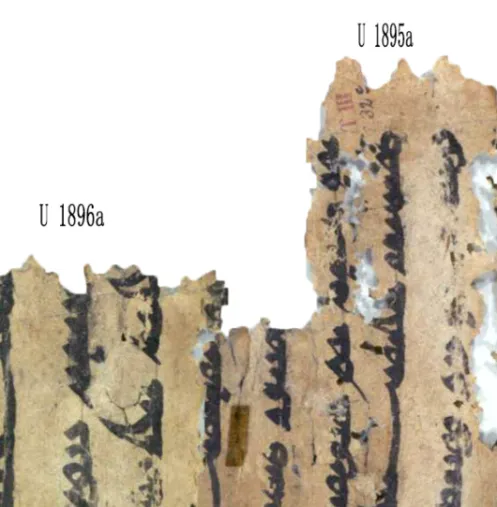A STUDY ON SEVERAL NEW FRAGMENTS
OF THE SÄKIZ YÜKMÄK YARUQ SUDUR IN UIGHUR SCRIPT
LI Gang
Faculty of Humanities of Xinjiang University
Shengli Road 666 Tianshan District of Urumqi, Xinjiang, P.R.C., 830046 Ghent Center for Buddhist Studies, Belgium ● Academia Turfanica, P.R.C.
e-mail: wjqlg2005@163.com
In this paper five new and unpublished fragments of a Buddhist sutra in Uighur script will be pre- sented. According to our research, they belong to The Scripture of the Divine Spell of the Eight Yang of Heaven and Earth Spoken by the Buddha, i.e., säkiz yükmäk yaruq sudur (SYY) (Fo shuo tiandi bayang shenzhou jing 佛說天地八陽神咒經, T85n2897). The first three fragments (T2 a/b, T3, T4) from Turfan were discovered by our technicians during their protection work of the cultural relics section while they were classifying, cleaning and repairing other objects. Due to several reasons, these documents have not been numbered up to now. Advised by our technicians we have num- bered them with the capital letter T. Two fragments (U1895 a/b and U1896 a/b)1 belong to the Turfan Collection of Berlin2. The paper mainly gives transcriptions, translations, and notes.
Key words: SYY, transcription and notes, translation.
1. The Description of Fragment T2 in the Database of the Project
Condition: fragment Size (cm): 17.5 × 16.5 Colour: dark yellow Thickness: thick
1 Here, I would like to express my gratitude to Peter Zieme who gave me some ideas and suggestions about the text decipherment; I am, however, responsible for all mistakes and misinter- pretations. I am also grateful to Dr. Ben Van Overmeire who kindly checked my English and made valuable comments.
2 The digital images are accessible in the Digital Turfan Archive of the Berlin Brandenburg Academy of Sciences and Humanities.
Hardness: soft
Paper quality: mid-range Script: Uighur
Handwriting style: block Contents: SYY
Remarks: with lower marginal line in red colour on both sides.
1.1. Transcription (recto) T2.a
01 [yoq quruγ-ta] öŋi ymä yïdyïp[ar] bul[tuqmaz]
02 [inčä ötgürü usar ötrü ol] oq yïdyïpar yänä yïpar 03 [yükmäk atl(ï)γ3 burq̇an titir] ymä tilin turqaru4 adruq 04 [adruq alqïnčsïz tatïγlïγ tat]ïγ tatar: ol kim tatïγlïγ tatïγ 05 [tip titir yoq quruγ ymä] ol oq ärür: ol kim yoq quruq titir 06 [tatïγlïγ5 tatïγ ymä ol oq ärü]r: tatïγ-ta öŋi yoq quruγ
07 [bultuqmaz yoq quruγ-ta6 ön]gi ymä tatïγlïγ tatïγ bultuq[maz]
08 [inčä ötgürü usar ötrü ol yo]q tatïγlïγ tatïγ yänä no[m ögrünčü]
(verso) T2.b 00 tört y(i)g(i)rmi:
01 [atl(ï)γ burqan titir. ymä] ät’öz-i turqaru adruq [a]d[ruq alqïnčsïz]
02 [säviglig börtmäk börtär : ol] kim börtmäk tip titir : [yoq quruγ7] 03 [ymä ol oq ärür : ol kim yo]q quruγ titir : börtmäk y(ä)mä ol 04 [yoq ärür : börtmäkdä8 öŋi] yoq quruγ bultuqmaz : yoq quruγ 05 [öŋi ymä börtmäk bultu]qmaz inčä ötgürü usar ötrü
06 [ol oq börtmäk yänä9 bilgä bi]lig yaltrïq-lïγ atlïγ burxan :
07 [titir : ymä köŋüli biligi10 turqar]u11 adruq adruq alqïnčsïz törü saqın 08 [-ur adïrar12 : ol kim törü tip titi13]r yoq quruγ y(ä)mä ol [o]q [ärür]
13 The original picture in Pchelin and Raschmann’s (2016) version has a dot above the letter γ.
14 Here, the letter q has two dots above, while there is only one dot in Pchelin and Rasch- mann’s version.
15 tatïγlïγ: IIc, cf. Oda (2015, 1289. 175, text volume).
16 quruqta: IId, cf. Oda (2015, 1290. 176, text volume).
17 yoq quruγ: Ia, IIc, cf. Oda (2015, 1293. 179, text volume).
18 börtmäkdä: Ia, cf. Oda (2015, 1294. 180, text volume).
19 ötrü ol ok börtmäk yänä: IIc, cf. Oda (2015, 1294. 182, text volume).
10 ymä köŋüli biligi: IIc, cf. Oda (2015, 1295. 183, text volume).
11 turqaru: Ia, Ib, cf. Oda (2015, 1295. 183, text volume).
12 törö saqïnur adïrar: Ib, cf. Oda (2015, 1296. 184, text volume).
13 tip titir: only attested here.
1.2. Translation (recto)
(01–08) Apart from (emptiness) (there is no taste) either, (if he is able to fathom this), that being (is said to be the Buddha named Accumulation of Fragrance); Again their tongues constantly (taste the manifold inexhaustible tastes), taste is precisely empti- ness (and emptiness is precisely taste), Apart from (smell and fragrance there is no nonexistence and emptiness), (Apart from nonexistence) there is no smell and fra- grance, (if he is able to fathom this) that being is said to be the (Buddha named) Dharma Joy.
(verso) 00 (leaf) fourteen
(01–08) Buddha, (named Dharma Joy), (he always feels various inexhaustible pleas- ant touches). What is called touch, (precisely that is nonexistent), (what is called non- existent and empty, precisely that is touch), apart from (touch) there is no nonexis- tence and emptiness; apart from emptiness (there is no) touch (either), if they could fathom thus he could be very much said to be the Buddha Wisdom Light, their minds constantly think about and differentiate manifold inexhaustible (Dharmas), the (Dharmas are precisely) emptiness and emptiness is (precisely Dharma) either.
Chinese original text (T85n2897_p1423b9-14) 香即是空,空即是香,即是香積如 來,舌常了種種無盡味, 味即是空, 空即是味; 身常覺種種無盡觸,觸即是 空,空即是觸, 即是智明如來, 意常思想分別種種無盡法, 法即是空, 空即 是 法。
1.3. Notes
1. Through comparing the text with the versions published by Pchelin and Rasch- mann (2016) and Oda (2015), we find the source of the Buddhist text here, which be- longs to SSY. In general the words and sentence patterns are very similar to the latter text, with only some divergences in word choice.
2. When we observe the damaged lacuna, we can discover that this text just has a lower marginal red line on both sides, which means that the top of this original text should have many missing Uighur scripts. Cross-referencing the scholarly editions of this text published thus far, we can supplement the lacunae in this badly damaged frag- ment. Up to now, there are no other versions found with the exact same words and sentences that appeared in this text except for Nikolai Pchelin and Simone-Christiane Raschmann’s new version in State Hermitage. Beside the latter, we also compare the extant text with the Chinese original, so that we can confidently conclude that the par- allel of this text is corresponding to Pchelin and Raschmann’s version, lines 23–37.
Comparing that, we have found that the version at hand is just a part of that preserved in State Hermitage published by Pchelin and Raschmann (2016).
3. See the two fragments version in Figure 1.
Figure 1. Comparison of two fragments
By comparing the two versions, we have come to the following conclusions.
Firstly, fragment T2a/b has a lower marginal line, even though there is much space for writing letters, more words should not be beyond the frame line, just like frag- ment Pl. 44. ВФ-4201. The length of each line of the Uighur text can be defined to some degree, as the missing Uighur words just appear on the top or partly at the bottom of this fragment (see Figure 1). In other words, the missing words could be emended according to Pl. 44 ВФ-4201. The left picture is taken from Pchelin and Raschmann’s edition as far as it corresponds to the Turfan fragment. Both parallel texts have the same number of Uighur text lines. By combining the two parallels and considering the content, we emended the text beginning with the words ‘yoq quruγ- ta’ in line 22 on the basis of Pchelin and Raschmann’s edition as the missing words of T2a. The remainder of the missing words of T2a and T2b could be found in the fol- lowing passage (lines 23 to 37) in Pchelin and Raschmann.
Besides this, there are some script features that help us to date the fragment.
In the whole text the letter /q/ has diacritical dots, i.e. written as q̇ or q, e.g. T2, r03, r04, burq̇an, turqaru. The letter /γ/ is sometimes written likewise with two dots as γ̇, e.g. T2, r03, r04, atlïγ̇, tatïγ̇-lïγ̇. Altogether this shows that the fragment should belong to the Yuan period.
2. The Description of Fragment T3–T4 in the Database of the Project
Condition: fragment
Size (cm): 17.5 × 16.5, 18 × 6.4 Colour: dark yellow
Thickness: thick Hardness: soft
Paper quality: mid-range Script: Uighur
Handwriting style: block Contents: SYY
Remarks: upper and lower marginal line invisible
2.1. Transcription (recto) T3+T4 T3
01 [käntü]n ulγatur14 qarïsar k(ä)nt[ün ] 02 [ymä] kntün ölür uzun[yaš tiläsär ] 03 [ö]l(ü) umaz : ämgäkli mäŋili [kntün15 ] T4
04 [ö]z qïltačï titir kimkä[
05 [qï]lïnč titir itig yara[tïγ qïlγalï saqïnsar16 ] 06 bitigig oqïzun ming tümän yïl[qatägi ] 07 [k]in yna burxan qutïn bolup [nomluγ17 ] 08 [tilgän ävirgäy tip yrlïqadï18 ]
2.2. Translation of Fragment T3+T4
(01–03) When growing up one grows up naturally, and when ageing one ages natu- rally.
If one (seeks) a long (life), one fails to acquire it, even if one says. ‘May I die!’ one is (unable) to die.
(03–04) Suffering and happiness arise of their own accord.
(05) If one thinks of performing an activity (please read this sutra)
14 ulγatur: cp. ulγadsar: Ia, Ib, Oda 2015: 1751, 449, text volume.
15 kntün: Ia, IIc, cf. Oda 2015: 1757. 451, text volume.
16 saqïnsar: Ia, Ib,IIc, cf. Oda 2015: 1759. 453, text volume.
17 nomluγ: IId, cf. Oda 2015: 1763. 455, text volume.
18 Oda 2015: 1763. 455, text volume.
(06–07) for myriads of years you could acquire the Buddhahood (you will be free from hazards) and (will turn) the
(08) (When the Buddha, god, spoke this Dharma discourse)
Chinese original text (T85n2897_p1425a22-28): 長乃自然長,老乃自然老,求長 不得長,求短不得短,苦樂汝自當,欲做有為工,千千萬萬世,得道轉法輪,
佛說此經已。
2.3. Notes
1. According to the contents of these two fragments, T3 and T4 could be joined. After reading and comparing the texts with the Chinese Tripitaka, the translation parallels to the SYY (T85n2897_p1425a20).
2. The parallel of this text is also corresponding to BT XXXIII 449–454.
3. There are several reasons why we can join the fragments. First, the left one is frag- ment T3, the right one T4. Based on the calligraphy features, they are written in regu- lar script, block-print. Second, in the content of two leaves, line 4 of T3, the first word öz qïltačï becomes very clear after joining fragment T3 and T4, particularly the dia- critical dot above the letter -q-. After further consideration it became obvious that the remainder parallels BT XXXIII 449–454. Last but not least, the shape of the two damaged fragments quite nicely fit each other, and the line width of the Uighur of these two fragments is almost the same. See the joined fragments in Figure 2.
3. The Description of Fragment U1895–U1896
The description of fragment U1895–U1896 in the database of the project runs as fol- lows
Condition: fragment
Size (cm): 11 × 9.5; 7.5 × 4.3 Colour: brown
Thickness: thick Hardness: soft
Paper quality: mid-range Script: Uighur
Handwriting style: block
Contents: (U1896a+U1895a) (SYY); (U1896b+U1895b) (unknown) Remarks: with upper marginal line in red colour. (U1895), U1896 invisible
3.1. Transcription (recto) U1896a + U1895a
01 [yoq qur]uγda öŋi [ymä yïd yïpar bultuqmaz inčä ötgürü]
Figure 2. Joined fragments
02 [usar ol t]ïnl(ï)γ yïpar yük[mäk atlïγ burqan titir ymä tilin]
03 [turqaru a]druq adruq a[lqïnčsïz tatïγ tatïγ ol kim tataγlïγ]
04 [tip titir] yo[q] olʾoq ärür19 : [ol kim yoq quruγ tip titir tatïγ]
05 [ymä tataγda] öŋi tataγl(ï)γ [tatïγ bultuqmaz inčä ötgürü usar]
06 ol tïnl(ï)γ nom ögrünčü a[tlïγ burqan titir ymä ätöz-i]20 07 turqaru adruq adruq [alqïnčsïz säviglig börtmäk21] 08 börtär ol kim börtmäk [titir : yoq quruγ ymä ol oq ärür22] 09 o[l] kim yoq quruγ titi[r börtmäk ymä ol oq ärür börtmäktä]
(verso) U1896b+U1895b
01 [ ]l[ ]l[ ]
02 [ tit]ir .. äŋʾilki [ ] 03 [ qal]tï bïšrunmaq [ ] 04 [ ]l[ ]m[ ]wy[ ]y [ ] 05 [ ] tözin kör[ ] 06 [ ]mäk ol . bu t[ ] 07 [ ] körkidä y[arlıqamïš//]
08 [ ] bu [ ]
09 [ ] y”[ ]
3.2. Translation
recto (U1896a+U1895a)
(01–06) Apart from (emptiness and nonexistence there is no smell and fragrance); (if he is able to fathom this) (the body of) that being (is said to be) the Buddha (Accu- mulation of Fragrance), (their tongues) constantly (taste all kinds of inexhaustible tastes), (what is called taste), (apart from taste there is no nonexistence and empti- ness), (precisely that is nonexistent and empty), that being (to be said to be the Bud- dha named) Dharma-Joy.
(07–09) (Again, his body) always (feels kinds of inexhaustible pleasant touches), what is called touch, (precisely that is nonexistent and empty), (what is called nonexistent and empty, precisely that is) touch. (Apart from touch, there is no nonexistence and emptiness; apart from nonexistence and) emptiness, (there is no touch either).
verso (U1896b+U1895b)
19 Here, yoq ol’ oq ärür is a little different from Oda’s version (Ib), cf. Oda 2015: 1289.
175. From here the content could be joined together, that is the joint between and U1896a and U1895a, see the joined plates in Figure 2.
20 atlïγ burxan titir ymä ätöz-i: attested only here, but very close to Pchelin and Raschmann 2016: 33, line 29.
21 alqïnčsïz säviglig börtmäk: attested only here, but very close to Pchelin and Raschmann 2016: 33, line 30.
22 titir :yoq quruq ymä ol oq ärür: attested only here, but very close to Pchelin and Rasch- mann 2016: 33, line 30.
(01)...; (02)…. said first all…; (03)… practising…. ; (04)…. ; (05)…to see the es- sence…;(06)… this….(07) … to deign to speak from (its) look…;(08)…this…
Chinese original text (T85n2897_p1423b9-12) 空即是香,即是香積如來,舌常了 種種無盡味,即是法喜如來,身常種種無盡觸,觸即是空,空即是觸。
3.3. Notes
1. By deciphering these two fragments, we found that fragments U1896a and U1895a could be joined. There are reasons for this. First, the content of fragment U1896a fol- lowed by Fragment U1895a is almost identical in meaning to Oda’s version. That is to say, the parallel of the joined two fragments is corresponding to BT XXXIII Ib.
171-180, see the joined plates in Figure 3.
Figure 3. Joined plates
2. Furthermore, it is obvious that the joint point of these fragments fits very well. The first line in fragment U1895a is just the continuum of the fourth line of fragment U1896a, the continuous words are ‘ol’ yoq ärür’, it is only the colour that is a little different, U1896 is lighter than U1895 on both sides (Figure 4). And we could also see that fragments U1895 and U1896 have much in common with Turfan Fragment T2 in content, the latter is more complete, and has more typical writing features re- flecting a later composition (Yuan dynasty).
Figure 4. Joined plates
3. While the side of the jointed fragment (U1896b+U1895b) is very difficult to de- fine, the word bïšrunmaq here is worth remarking on. In Oda’s version of the säkiz yükmäk yaruq, we found the word only appeared once in the sentence ‘saqïnmaq bïšrunmaq tözlüg bo üč törlüg bilgä biliglär ärür’. As we could not find any parallels in this sūtra (SYY), because of limited extant content, this may be a different Buddhist text, and it would be worth studying it further in the future. The joint fragments can be seen in Figure 4.
Abbreviations and References The Uighur text has been transcribed in the following manner:
a ä b č d i γ γ̇ g ï k l m n o ö p q̇ q r s t u ü(ṳ) v w x y z ṳ: alternative spelling for ü in the first syllable of a word q̇, q:diacritical dot(s) above -q-.
+: joint
[ ]: uncertain reading or lacuna due to damaged manuscript ( ): supplementing the missing vowels
//: the number of missing words
BANG, Willi, Annemarie von GABAIN and Gabdul Rašid RACHMATI 1934. Türkische Turfantexte. VI.
Das buddhistische Sūtra Säkiz Yükmäk. [Sitzungsberichte der Preussischen Akademie der Wissenschaften. Phil. hist. Kl. 1934: 10.] Berlin: Verlag der Akademie der Wissenschaften.
[Reprint in: Sprachwissenschaftliche Ergebnisse der deutschen TurfanForschung. Band 2.
Leipzig: Zentralantiquariat der Deutschen Demokratischen Republik, 1972, 190 – 289].
BT XXXIII = ODA (2015).
CLAUSON, Gerard 1972. An Etymological Dictionary of Pre-Thirteenth-Century Turkish. Oxford:
Oxford University Press.
DANKOFF, Robert and James KELLY 1985. Compendium of the Turkic Dialects. Cambridge, Mass.:
Harvard University.
KARA, Georg and Peter ZIEME 1986. ‘Die uigurische Übersetzung des apokryphen Sūtras „Fo ding xin da tuo luo ni“.’ Altorientalische Forschungen 13/2: 318 – 376.
ODA, Juten 小田壽典 2015. A Study of the Buddhist Sūtra Called Säkiz Yükmäk Yaruq or Säkiz Törlügin Yarumïš Yaltrïmïš in Old Turkic. Turnhout: Brepols Publishers.
PCHELIN, Nikolai and Simone-Christiane RASCHMANN 2016. ‘Turfan Manuscripts in the State Her- mitage—a Rediscovery.’ Written Monuments of the Orient 2/2: 3–43.
RASCHMANN, Simone-Christiane 2012. Alttürkische Handschriften. Teil 18: Buddhica aus der Ber- liner Turfansammlung. Teil 1: Das apokryphe Sutra Säkiz Yükmäk Yaruk. Mit einem Appen- dix von Rischel, Anna-Grethe: Old Turkish Fragments from the Berlin Turfan Collection.
Paper Analysis of 62 Manuscripts and Block Prints. [VOHD XIII, 26.] Stuttgart: Franz Steiner Verlag.
ZIEME, Peter 2005. Magische Texte des uigurischen Buddhismus. [Berliner Turfantexte 23.] Turnhout:
Brepols Publishers.
Plates
T2a, recto
T2b, verso
T3
T4
U1895a U1895b
U1896a U1896b



